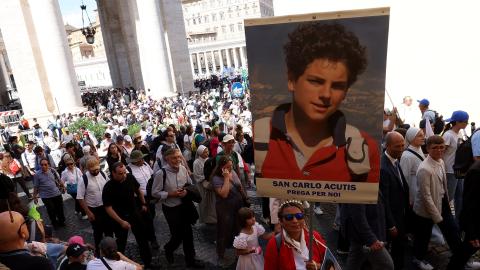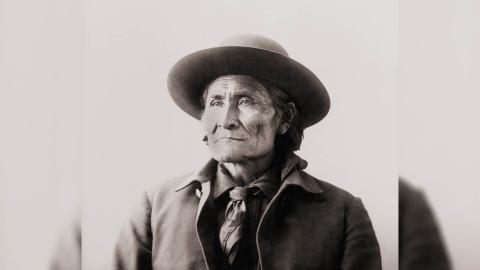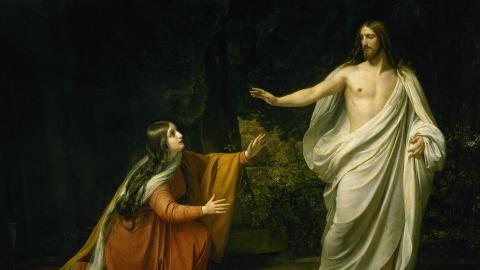The Templars in Iberia: the Reconquista and the Spanish crusades
Spain before the Moors
Before the huge military campaign of the Templar knights and other independent soldiers descending across Spain’s southern territories to retake lands ruled by Muslim leaders, the peninsula had been governed by invaders from north Africa for hundreds of years. In the early 700s, Berber Muslims from North Africa, often called Moors, had conquered nearly all of the Iberian Peninsula, the mountainous region most associated with Spain and Portugal. But over the following seven and a half centuries, the Christian kingdoms to the north gradually retook control of the peninsula, and by 1300, Muslims controlled only Granada, a small region in the south of present-day Spain.
The name Gibraltar means ‘mountain of Tariq’ in Arabic
Prior to the Muslim invasion of Spain in the 8th century the Iberian Peninsula was ruled by the Visigoth tribes for two centuries before it was colonised by the caliphate Umayyad empire. The Iberian Peninsula had been part of the Roman Empire and was converted to Christianity in the fourth century. It was then conquered in the early fifth century by the Visigoths, who were Arian Christians from southern Scandinavia and the north of Germany. They occupied what is now south-western France and the Iberian Peninsula from the 5th to the 6th centuries, establishing kingdoms in Gaul and Spain.
Seven years to conquer southern Spain
The Umayyad Caliphate was the second of four major caliphates which ruled over a vast multiethnic and multicultural population which included Spain and north Africa, stretching as far as Damascus and Mecca in the Middle East. It took the Umayyad caliphate seven years to conquer the Iberian Peninsula in this early ‘jihad’ holy war which saw the Arabs forcing their way east and west in a breathtaking expansion of power.
In the second half of the seventh century they conquered the whole of North Africa. In 711 Tariq ibn Ziyad, a Berber Umayyad commander, crossed the Straits of Gibraltar, consolidating his troops at what is known today as the Rock of Gibraltar and destroyed the Visigothic kingdom of Spain. The name Gibraltar means ‘mountain of Tariq’ in Arabic and is named after him.
'A protection racket' between the Muslims and the Christians
The Christian rulers in northern Spain and the Muslims tolerated each other in a political-financial arrangement in a form of co-existence after the northern kingdoms took advantage of Muslim principalities (taifas) that had become fragmented and weakened. After having fostered the threat of civil war the Christians intimidated Muslim rulers charging them a form of protection money called parias, in the exchange for their alliance and loyalty, and in return for not attacking them. The situation was similar to that in the Holy Land in the twelfth and thirteenth centuries where the Latin Christian lords allied with Muslim lords for mutual advantage. As in the Holy Land, Christian rulers in Spain would also ally with Muslim rulers against other Christians. Far from being straight forward the bloody history of Spain and its early presence of Muslim kingdoms demonstrates a turbulent power game between Christian rulers and Muslims where a level of tolerance existed usually because of the exchange of money maintaining the status quo.
The waging of crusades in Spain depended largely on the ability of its Christian rulers to undertake further steps in the process of recovery or alternatively on their need to defend their lands against Muslim counter-attacks. The irony being that there was a good deal of co-operation within each society between Christians and Muslims. In Muslim Spain lived Christians who had adopted Muslim customs but not converted to Islam: these Christians were known as Mosarabs. When Christian conquerors defeated Muslims in Christian Spain they often allowed them to follow their religion and mosques remained open. They did this because, just as in the crusader states, there were not enough Christians to populate the newly conquered lands.
The Muslim power vacuum emboldens Christian Kings
From 756 the Iberian Peninsula was independent from the rest of Islam and from 929 it had its own caliph, or religious leader. But by the early eleventh century the caliph’s power was breaking down; the last caliph was deposed in 1031. The Muslim territories split into Taifa states, or ‘party states’ identified with different ethnic groups, such as the Berbers on the south coast. The Taifa states were rivals, and there was no united front against the Christian attack. The power vacuum drew in the Christian rulers from the north. In the eleventh century the main Christian kingdoms were Leon, Castile and Aragon; in addition there were the counties of Portugal and Barcelona.
The Templars join the resistance against Muslims in Spain
For a long time there had been wars against the Moors in Spain and Pope Urban II tried to dissuade Spaniards from joining the First Crusade in the Holy Lands, establishing an analogy between the reconquests of the peninsula and Palestine. Spain had once been a Christian land, but great tracts of it were by now subject to Muslims, who now threatened the faithful in the north. Christian rulers of the north were determined to push south into the lands the Muslims had never colonised thoroughly. Although they presented this to their subjects and to other Christians as religious expansion into lands that were to them morally and rightfully Christian, they also wanted to win new territory and wealth.
Ramon IV of Barcelona became an honoury member of the Templars in 1134
However, the Templars still remained hesitant to commit troops to the crusade in Spain, mainly because their resources were still sparse and they felt that they should dedicate everything to the Holy Land. Ramon IV of Barcelona became an honoury member of the Templars in 1134 and gave them generous donations . He was the first Aragonese noble to decide that he wanted active Templar military support in his wars with the Muslims. So he did all that he could to persuade them to commit troops to his campaigns. In 1143 Ramon IV united his county to the crown of Aragon. With their ally in such a prestigious position the Templars finally entered into the Spanish crusade in force.
The crusade to Spain: Was the Reconquista for God or money?
The Reconquista meaning to ‘reconquest’ related to the activity of the Templar Knights taking back land, mostly in southern Spanish territories that had been invaded by Muslims. It was a decision encouraged by civil wars within the Cordoba Caliphate in 1031 which led to five Spanish provinces, Aragon, Castile, Catalonia, Navarre and Leon taking advantage of the Caliphate’s political turmoil and planning to retake southern lands. The Reconquista was a brutal conflict fuelled in part by devotion to Christianity but mainly a crusade against infidels. In al-Andalus - the Arabic name for Muslim-controlled Iberia - Christians and Jews had significant religious freedom. But the Christian rulers to the north did not return the favour of toleration. The rulers of Spain's kingdoms realised that their shared Christianity could unite them and set them apart from the Muslims to the south.
The knights who were ready to fight in the Reconquista were convinced of their superiority to their enemies who had rejected Christianity, and they developed rules of war based on that superiority - including the right to enslave the people they conquered. The eventual damaging and long-lasting legacy of a re-conquered Spain, both culturally and ethnically, was that Muslims and Jews were forced to convert to Christianity or be expelled from Spain.
The Templars and their incentives to fight in Spain
After the First Crusade Pope Alexander II (1061-73) recognised the war against the Muslims in the Iberian Peninsula as a crusade. The Iberian kings had complained to the pope that their warriors wanted to go on a crusade to the Holy Land, yet they needed them on the Iberian frontier to fight the Moors (the Iberian Muslims). In 1100 and 1101 Pope Paschal II (1099-1118) banned Spanish knights from going on crusade to the Holy Lands while the Moors were a danger in the Iberian Peninsula. He also declared that anyone going on crusade against the Moors would have the same ‘remission of sins’ as if they had journeyed to Jerusalem. During the first few decades of the twelfth century the Iberian frontier came to be generally recognised both within the Iberian Peninsula and in the rest of western Europe as a crusading arena.
The Spanish crusades, like those to the East, were portrayed as being defensive, although it was occasionally maintained that the Reconquest would be the key to the unlocking of a route to Jerusalem by way of North Africa. In 1125 the Archbishop of Compostela put a religious spin on the urgency of a crusade to Spain when he argued that ‘Just as the knights of Christ...opened the way to Jerusalem...so we should become knights of Christ and, where defeating his wicked enemies the Muslims, open the way to the Lord’s Sepulchre through Spain, which is shorter and much less laborious’ thus the Spanish crusades soon developed their own specific urgent criteria to be undertaken. They were envisaged as wars of national liberation as ordered by monarchs.
The support of the papacy also speeded up the ‘reconquest’ because this helped recruit warriors for campaigns in Spain. A letter of Pope Alexander II survives, which states that those who were intending to journey to Spain were to confess their sins but would not have to do any penance because the expedition would be penance enough. Alexander was offering incentives to warriors who went to Spain similar to those offered later to crusaders – although not a complete remission of all sins. Warriors came to Spain from Normandy, Aquitaine, Burgandy and elsewhere in France. By the 1140s both the Templars and the Hospitallers’ orders would commit knights to the Reconquista. Besides the Iberian peninsula would see the formation of its own local military orders, starting with the Order of Santiago (1170), Montjoy in Aragon (1173) and Alcantara (1176).
Who were the Templars as soldiers?
Most of the Brothers of the Order of the Temple came either from the lower ranks of knights or were not of knightly descent at all; many were craftsmen, or people who performed ordinary agricultural tasks such as herding sheep and cattle. People of these social groups left very few records, but through the surviving evidence from the Templars we can catch some glimpses of their beliefs, what mattered to them, and their everyday lives. They were loyal to their families, to their old lords and their king, even when they had joined the Order of the Temple and were supposed to have left all their old ties behind.
Allegedly celibate, although that notion in reality is debatable the Templars were known to be devout soldiers embracing a simple faith based on Christ as king and Christ’s mother and bride, the Blessed Virgin Mary, as patroness and lady of the Order, who protected it as a medieval queen would protect her favourite religious Orders and knights. Their dearest desire was to lay down their lives on the battlefield in the war against evil, defending Christendom against its enemies, in the service of their divine king and queen, and so to win the reward of eternal life in Heaven, wearing the martyr’s crown.
Dissenters viewed the Templars in a different light, believing that money was their only love and not religion. There is no denying that they were best known in everyday life for their financial activities: looking after the treasure of the crowns of Europe, and financial services for nobles, knights, merchants and squires. One view of them as medieval bank managers and clerks in robes with fighting skills paints a clearer picture of how people in cities around Europe regarded the Templars at the time. Finally, the knights were driven by a desire for land and profit and as most military actions against the Moors were privately financed, and since leaders of armies had risked their own money, they won rights from kings to conquered land and a share of conquered peoples' wealth.
Justifying war against the Muslims
The fundamental shift in the Templars deciding to set out on the Reconquista was due to the changing character of relations between Christian and Muslim. The restraint which had marked them was gradually replaced by more aggressive attitudes on both sides of the religious divide. It seems impulses were generated outside the Iberian peninsula. The agents of change were the incoming French adventurers who were establishing themselves in Spain in the period 1080 – 1140 and the activity of Berber devotees of an Islamic fundamentalist sect, the Almoravides, who overran Muslim Spain (1090 -1120), all of which created greater urgency for a Christian army to act.
Replacing a policy of merely exploiting Muslim neighbours in Spain a programme of ‘reconquest’ was given a sharper edge by the notion of a crusade. Wars against Muslims were seen as righteous wars in which God fought on the Christian side and the promise of heaven for those soldiers who gave their lives to the cause was a powerful incentive.
The conquest of Toledo
The beginning of the Reconquista in Spain is traditionally marked with the Battle of Covadonga (722) which is documented as the first known victory in Hispania by Christian military forces since the 711 military invasion, undertaken by combined Arab-Berber forces. Many other cities in southern Spain’s territories were reclaimed years later by the Christian army but one in particular, the city of Toledo, once the capital of Christian Spain, represents the kind of Christian religious fervour to reconquer former Spanish provinces. King Alfonso’s VI’s account of his conquest of the city in 1085 demonstrates strong self-righteous feelings of hatred against the Muslims.
‘I took up arms against the barbarian peoples. After many engagements and innumerable enemy deaths with the assistance of God’s grace I captured from them populous cities and very strong castles. Inspired by the grace of God I moved my army against this city where once my forebears reigned: believing that it would be pleasing in the sight of God if what once a treacherous people under their evil leader, Muhammad, had stolen from the Christians, I Alfonso the emperor under the leadership of Christ might restore to the worshippers of the same faith...’
Alfonso VI stormed into Toledo in 1085, marking a significant victory on the long road of the Reconquista. Shortly thereafter, the Vatican recognised Toledo as a seat of the Church in Spain. The expulsion of non-Christians from Spain due to the Reconquista had the ultimate effect of driving Muslims out of the Iberian Peninsula, and contributed to the unification of a single Spanish kingdom.
The recapture of Toledo, which had been the Visigothic capital before the Muslim invasion, was a major propaganda coup for Alfonso as he could claim to be restoring the Visigothic empire and to be the rightful ruler of the whole of the Iberian Peninsula as the Visigothic king had been. The conquest also raised the prestige of Castile because Toledo possessed a large library, and kings of Castile became famed as patrons of learning.
The legacy of the Reconquista
The Military Orders did more than provide supplementary military forces for the use of rulers in Iberian Peninsula. As in the East, the Templars also assisted crusaders who arrived elsewhere in Europe en route by sea to the Holy Land. Their assistance for Afonso Henriques of Portugal in 1147 in the capture of Santarem was followed by the attack on Lisbon which was completed with the assistance of English, German, Flemish and Boulogne crusaders on their way to the East.
The Reconquista in Spain had the ultimate effect of driving Muslims out of the Iberian Peninsula, and contributed to the unification of a single Spanish kingdom. Following the retaking of the lands once governed by Muslims which wasn’t completed until 1492, there were efforts to force Muslims and Jews to convert to Catholic Christianity if they wished to remain in the land. The Reconquista had been pursued on and off since the 8th century, but was eventually and successfully carried out by Catholic Monarchs Ferdinand II of Aragon and Isabella I of Castile , who completed the conquest over Muslims in Granada after the province’s fall. Their success against the Muslim presence in the peninsula advanced their control over all of Spain and under their son, King Charles I, Spain was ruled as a single kingdom.
The reconquerer knights were tough, self righteous believing god was on their side and not averse to use savage brutality to win battles. Despite their devotion to God, king, and queen; they were also eager for wealth and glory. And after 1492, with the Reconquista complete, they were in the market for a new crusade, namely to retake the Holy Land from Muslims. One world-changing aspect of the Templars first taking back and reconquering lands in Spain is the fact that less than 350 years later, Spain, eager for new sources of wealth and opportunities to spread Christianity, decided to give Christopher Columbus a chance and sent him to sea. His navigational mistake believing that he had found and explored mainland Asia, but was in fact the Americas, has been one of the most important events in history and the beginning of the greatest oppression of indigenous people the world has seen during the medieval age.
















